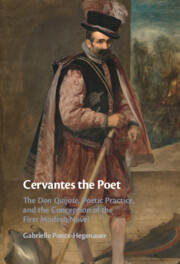 Cervantes the Poet
Cervantes the Poet Book contents
- Cervantes the Poet
- Cervantes the Poet
- Copyright page
- Dedication
- Contents
- Figures
- Acknowledgments
- Note on Abbreviations, Translations, and Terms
- Introduction The Unknown History of the Conception of the Don Quijote
- Chapter 1 Mimesis in the Court of Gentlewomen: The Pastoral Fabric of Everyday Life
- Chapter 2 Exalted Apostrophes: Cervantes in the Court of Isabel de Valois
- Chapter 3 Figura of the Poet: Pastoral Petrarchism as the Practice of Ingenious Gentlemen
- Chapter 4 The Form of Beauty: Lyric Lovers in the Mediterranean World
- Chapter 5 The Poet as Literary Character: Eclogues and Encomia in Madrid
- Chapter 6 The Literary Character as Poet: Lyric Subjectivity, Chronotopic Dynamism, and Plot in the Galatea
- Coda Alonso Quijano’s Lyric Subjectivity:
- Index
Introduction - The Unknown History of the Conception of the Don Quijote
Published online by Cambridge University Press: 11 May 2023
- Cervantes the Poet
- Cervantes the Poet
- Copyright page
- Dedication
- Contents
- Figures
- Acknowledgments
- Note on Abbreviations, Translations, and Terms
- Introduction The Unknown History of the Conception of the Don Quijote
- Chapter 1 Mimesis in the Court of Gentlewomen: The Pastoral Fabric of Everyday Life
- Chapter 2 Exalted Apostrophes: Cervantes in the Court of Isabel de Valois
- Chapter 3 Figura of the Poet: Pastoral Petrarchism as the Practice of Ingenious Gentlemen
- Chapter 4 The Form of Beauty: Lyric Lovers in the Mediterranean World
- Chapter 5 The Poet as Literary Character: Eclogues and Encomia in Madrid
- Chapter 6 The Literary Character as Poet: Lyric Subjectivity, Chronotopic Dynamism, and Plot in the Galatea
- Coda Alonso Quijano’s Lyric Subjectivity:
- Index
Summary
The Introduction begins with the situating of the DQ at a turning point in Foucault’s History of Madness in order to draw out the fate of the Renaissance poet as that which Cervantes’ modern novel most obviously and most covertly dramatizes. Positing the unknown history of the Don Quijote as the oft-elided career of nearly four decades that Cervantes spent as a sixteenth-century author of pastoral verse and prosimetric poetry, the Introduction reconfigures the history of the modern novel through the reconstruction of sixteenth-century poetics, the poetics of Pastoral Petrarchism. While Velázquez’s Las Meninas has often been studied as a paradigmatic work of the transition from Renaissance to Baroque (oft-coupled with the DQ), the Introduction returns to Velázquez’s painting of El bufón llamado don Juan de Austria in order to more closely examine Cervantes’ role in this transition as an aging contemporary of the original Don Juan de Austria, a favorite patron of poet-soldiers. Engaging both the figure of the poet and the figure of the modern madman in the transformations of the DQ as exemplar of the modern novel and the modern subject, the Introduction lays the historical foundations and theoretical stakes of Cervantes the Poet.
Keywords
- Type
- Chapter
- Information
- Cervantes the PoetThe <i>Don Quijote</i>, Poetic Practice, and the Conception of the First Modern Novel, pp. 1 - 21Publisher: Cambridge University PressPrint publication year: 2023


